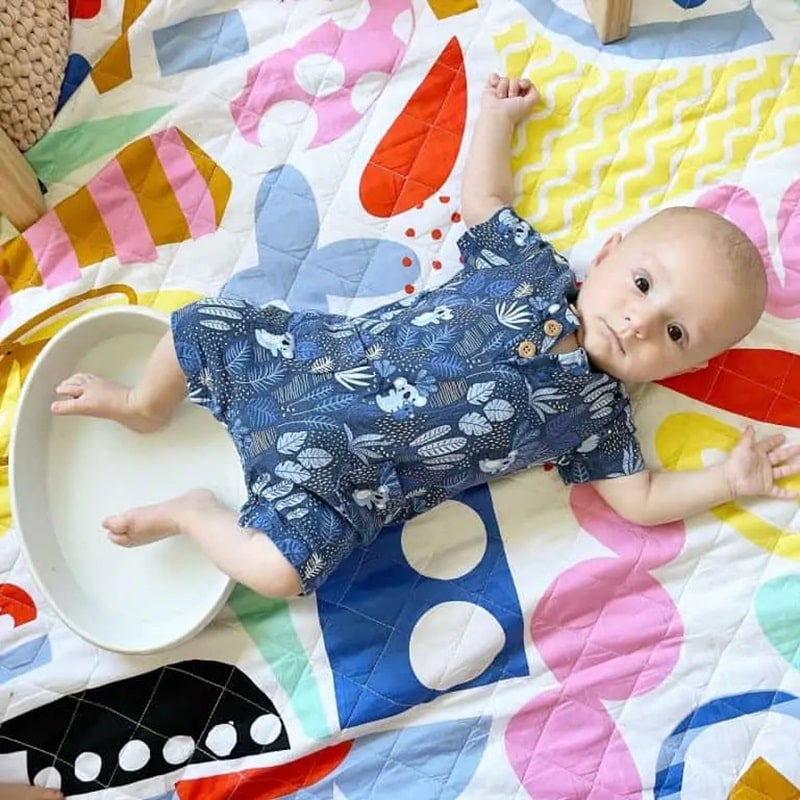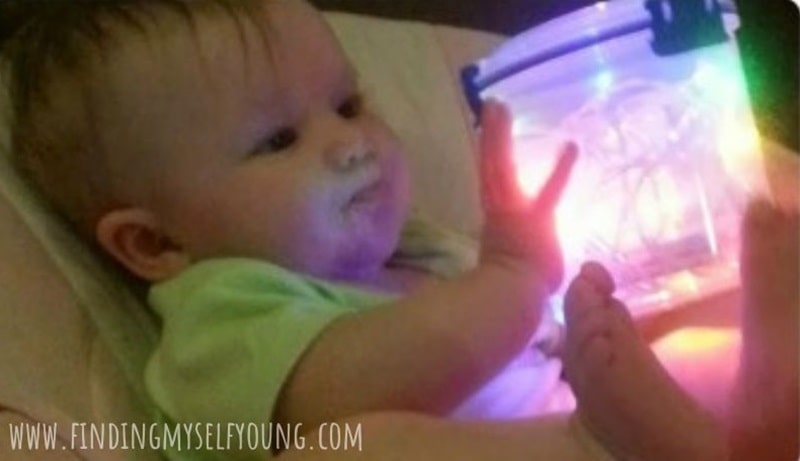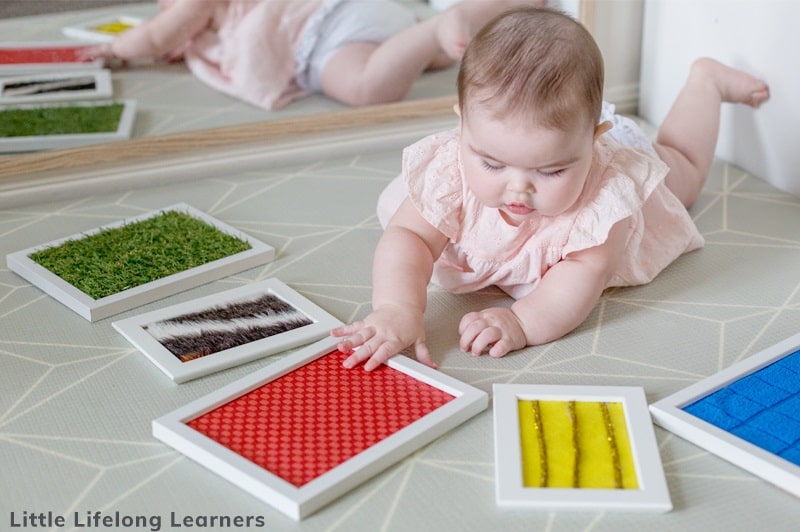Sensory play is an important tool for developing skills even in children as young as babies. Sensory play builds neurological pathways and helps children to explore and make sense of the world around them by using their five senses, sight, smell, hearing, touch and taste.
I've put together a list of sensory play activities for babies aged 0-6 months that you can do at home to start building their developmental skills and most importantly they're also heaps of fun, for baby and you.
SENSORY PLAY FOR YOUNG BABIES
Although young babies, especially newborns can't do much in the way of movement, or even controlling their extremities, they can still engage in many types of sensory play. For babies up until 6 months old I focus on visual, auditory and tactile sensory activities to improve their ability to feel, see and hear different sights, sounds and items.
Young babies generally explore everything with their mouth, especially before they work out how to properly grasp items in their hands, however it's important not to introduce any food based sensory play until after they've started solids. If you're after taste safe sensory play ideas check out my post of sensory play ideas for babies 6months + .
The sensory play ideas for babies included in this post will help them to build essential development skills such as visual perception, eye tracking, hand/eye coordination, core strength, fine motor and movement skills such as grasping and transferring items.
As always all of these activities are to be done under strict parental supervision and babies should never be left unsupervised with sensory materials. For more early baby play ideas check out this post of 2 month old baby activities.
Black & white high contrast images
When babies are born their eyesight isn't very developed and they can only distinguish between high contrast colours such as black and white, rather than seeing a myriad of colours like we can as adults. To help strengthen their eye sight you can provide basic high contrast images in varying patterns of black and white for them to focus on. These are great to add on a wall next to their change table or floor play area.
You can download a set of 16 free high contrast images here. There are also many soft fold out high contrast books that can be used during tummy time. If you want to provide visual stimulation from another perspective you can also create a high contrast hanging mobile to place above their cot or play gym.
Mirror play
Babies love to look at your face and facial reactions to learn about the world and they can also do this by watching their own face in a mirror. Babies will love having access to a mirror from a young age to learn about their own identity and the world around them {even if it's just the reflection of the room they're in}.
Mirrors are a great way for babies to practice eye tracking, learn and recognise emotions through facial expressions, learn about object permanence and cause and effect as their mirror image reflects the movements they're actually making.
In the Montessori method, babies are given access to a long acrylic mirror on the floor from birth so they can interact with their reflection and experience the world around them from different perspectives. Floor mirrors are also a great way to encourage babies to spend more time on their tummy and help develop their core muscles. Learn more about mirror play in Montessori here.
Even if you don't follow Montessori, or you don't have the wall space for a long floor mirror, you can get smaller portable sensory floor mirrors that are great to use on a tummy time mat.
Balloon kicking
Babies naturally kick their legs and arms when lying down long before they can crawl or actually physically move. You can take advantage of this movement to help with their eye tracking and to teach cause and effect by using a helium balloon for balloon kicking.
Attach a helium balloon to their foot or hand so it floats up high enough above them that they can't actually grab the balloon itself, but they'll quickly realise as they move their feet or arms the balloon also moves. They'll have fun watching the balloon bob up and down as they make different movements. Make sure the balloon isn't tied to them too tight and always make sure they're supervised so they can't become tangled in the ribbon.
Musical toys
Musical toys are the perfect way to provide auditory stimulation to babies {besides talking and singing to them yourself}. Once baby is old enough to grasp they can hold and shake numerous musical toys such as maracas, shakers, rattles and rain makers.
Moving the toys around to create sound helps babies with coordination, fine motor skills and cause and effect as they realise when they move the toy a certain way it will make a sound. They're also a great way to encourage talking as babies will naturally babble along with the sound.
Sensory mittens
Babies love to explore everything with their mouths and a fun way to give them more safe sensory stimulation via their mouth is with a sensory glove or mitten. From 3 months old when they can confidently move their hands to their mouths you can use a sensory mitten which is fitted to their hand and has sensory items sewn onto it as well as silicone chewing pads which help relieve teething pain.
We used a Gummee Glove which you can get in Australia, however there are plenty of other sensory mitten alternatives. Just ensure you check it regularly to make sure there is no fraying material or damage to the silicone sections before each use. You can also get sensory wrist straps and foot socks that will make noise when baby moves.
Parachute play
Young babies that can't move around yet will love laying under a parachute and watching the fabric float up and down above them. This will help with eye tracking as they watch the patterns move around as well as tactile sensory input as the fabric drapes over them softly and the feel of the wind blowing on them from the movement.
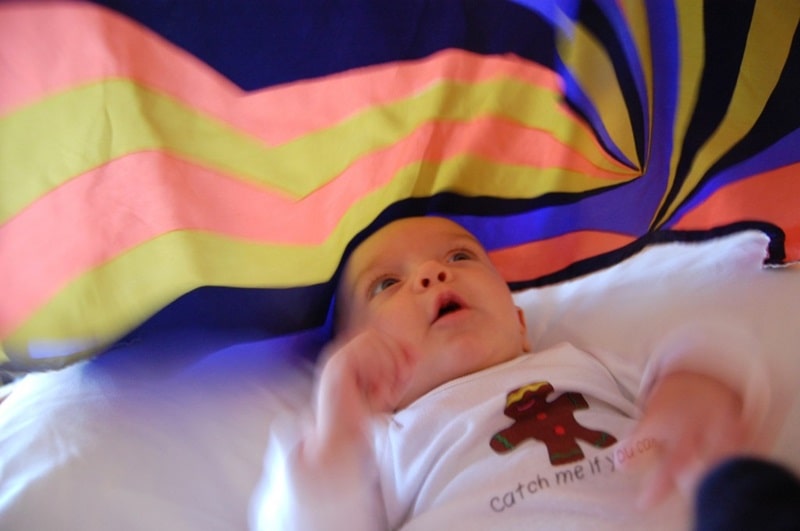 |
| Image: Tinkerlab |
If you're doing this with just one baby you can use a simple silk scarf, try to pick one with fun patterns to make it more visually appealing for baby to focus on. If you want to do this activity with a group of babies at mother's group or a sensory class, you can get a proper colourful parachute that's big enough to use over a number of babies at one time.
Ribbon play
Another fun way to provide both visual and tactile stimulation is to hang different coloured ribbons from a play gym for baby to touch and feel while they're lying on the play mat. Use ribbons of different textures, width and transparency to stimulate even more curiosity.
Baby will be encouraged to reach and grab for the ribbons and can feel the different textures as they touch them or they drape on their face. They can also watch how they move when they let go and they fall. Make sure the ribbons are adequately secured to the play gym so they can't be pulled off.
Water play
Young babies engaging in water play may seem counterintuitive given the dangers of young children around water sources, however you can actually introduce babies to water play from a young age as long as you do it in a safe way. Set up a shallow dish of water and let baby naturally dip and kick their feet into the tray as they lay on a baby mat.
The temperature, wetness and movement of the water will all provide baby with tactile stimulation. You can also use spoons or cups to tip a small amount of water over their feet. Make sure you only use water play under strict adult supervision and the water isn't too cold or hot.
Sensory umbrella
If you want to create a cosy sensory area for your baby to relax in that isn't a typical play gym or baby play mat, you can create a DIY baby sensory area with an umbrella. An umbrella is a great tool to use as sensory items can be hung onto the wire arms so babies can look at them hanging and moving, but they're still out of reach enough that they can't grab them and pull the umbrella down onto themselves.
Having only the centre pole there's also plenty of room for your baby to lay underneath on soft blankets. I love how Mihaela has used velcro cable ties and old CD's to make DIY hanging toys with bright colours and light reflections that are visually stimulating. If you want to make this with a younger baby you could use a black umbrella and black and white hanging sensory toys.
Never leave babies unattended with a sensory umbrella as they could accidentally kick it over.
Sensory bean bags
A great way for babies to explore different textures of fabric is to use sensory bean bags. Typically sensory bean bags for babies are made in small square or triangle shapes that are easy to grasp and are filled with either sand, rice or beans to add a bit of weight.
 |
| Available at Mimia Montessori |
They can hold the bean bags and feel if they're soft, rough, bumpy or smooth. Using different coloured fabrics will also add more visual stimulation.
Sensory balls
Sensory balls were a big hit with both my girls from a young age. You can see in the basket below we used a variety of sensory balls in different sizes, colours and textures. A lot of them had different grooves and indents on them so they could run their fingers along them. We also had ones that could be twisted and ones that were filled with bells or beads to make noise when they're rolled or shaken.
Initially I would present them in a discovery basket, however as babies get better at tummy time and their hand control you can also present them in muffin tins. This adds a different element where they can pick up and put them back into holes and move them around into different positions which helps build their hand/eye coordination, visual perception, spatial awareness and fine motor skills as they grasp and move the balls.
Sensory hoop
A sensory hoop is a great way to encourage baby to reach for and grasp items of different textures while they're doing tummy time. You can put baby on the outside or the inside of the sensory hoop on their tummy. Looking at all of them items will also encourage them to keep their head up longer and if they're in the centre they're likely to try and move around to get to different items which helps develop their core strength.
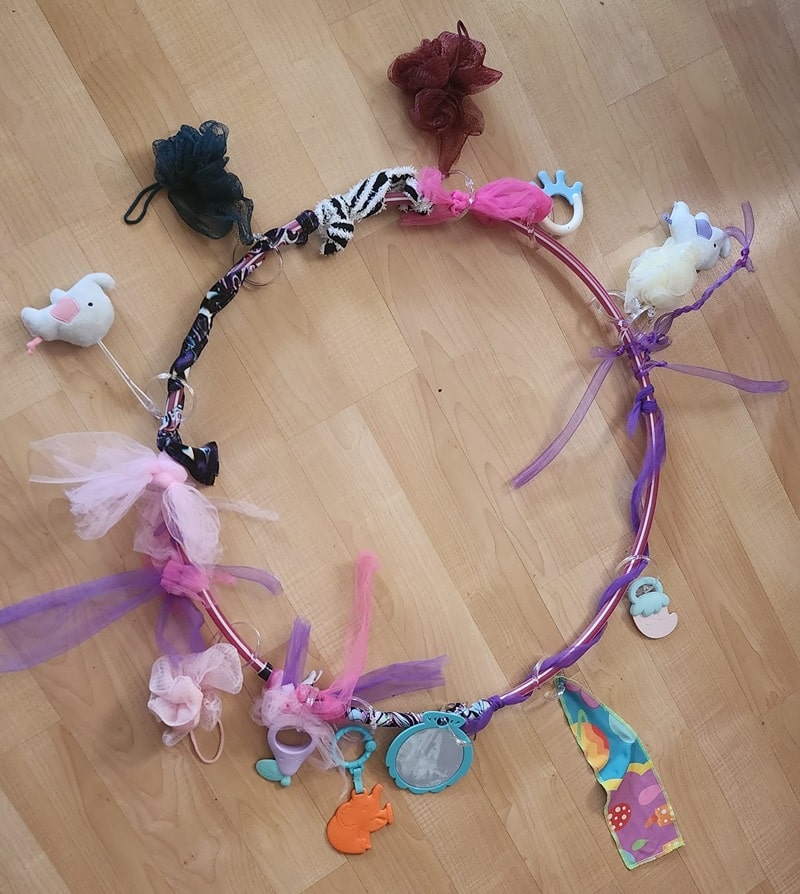 |
| Image: Samii Lee {supplied} |
You can make a DIY sensory hoop using a plastic hula hoop and adding different textured fabrics as well as hanging items onto the hoop. You can use fabric from old clothing or off cuts and loop it around the hoop, make sure it's tied off securely so baby can't detach it. You can also clip hanging baby toys onto the hoop or use shower curtain rings to attach items like teethers or shower puffs.
Make sure all items are securely attached to the hula hoop and inspect it regularly to make sure no items are getting loose. Always use under direct supervision.
Light cave
Recycle a cardboard box to create a light cave for your baby by poking holes in the top and pushing individual fairy lights through the roof of the box. Use a set of battery operated led lights {similar to these} to ensure the lights don't get hot. By poking them through the cardboard box, the cord and battery pack won't be accessible to baby.
For safety I suggest using a cardboard box that's tall enough so that bub can't actually grab the individual lights when they're lying under them. You'll also want to add a soft blanket or baby mat into the box to support their head while they're laying inside. If you have colour changing lights you can also explore different colours.
Portable baby light play
If you want a more portable light play option then make one of these sensory light containers. I initially made ours to give bub a safe way to explore Christmas lights as she was fascinated with the ones on the Christmas tree, but due to obvious safety reasons I didn't want her trying to touch those.
By putting battery operated lights into a container she couldn't open, she could safely hold the container and look at the lights without actually getting to the wire or batteries. It was great for her to play with in her bouncer, in the bumbo and also on the play mat during tummy time.
Sensory bags
Small items that pose a choking risk are obviously not safe for young babies to explore with their mouths, however you can still give babies a safe way to explore these items by creating baby sensory bags. By placing the items inside a thick plastic bag with either water or hair gel inside, babies can explore the items by squishing and poking the bag without actually getting to the individual items.
When you make a sensory bag it's important to thoroughly seal the bag either with thick tape {as above}, or you can make them with laminating pouches and seal the ends shut by using a hair straightener to melt the plastic together. Sensory bags are best used with babies who don't have teeth yet, or tape them to a surface so they can't chew the bag itself. Also make sure babies nails are trimmed so they can't accidentally tear the bag by scratching it.
Touch and feel sensory frames
Introduce babies to different textures and help prolong tummy time or encourage crawling by creating some DIY sensory frames. You'll need some picture frames and a selection of fabrics that have various textures such as velvet, minky, faux fur, flip sequins, faux leather or satin. You can also use artificial grass off cuts. Hot glue the fabrics to the backing of the frames and then secure them into the frames, without adding the glass or acrylic panel.
The frames can then be laid flat on the ground in front of your baby for them to touch and feel. This is a great way for them to safely explore different textures such as soft, hard, rough, smooth or bumpy. As they get older the frames can be hung low on a wall the encourage vertical play or attached to a sensory board. Always ensure children are supervised while using sensory frames incase some fabric accidentally comes loose.
Sensory shaker bottles
I made these sensory shaker bottles when my baby girl was a few months old, mainly to introduce her to different sounds and show how shaking things fast and slow can change the sounds. I also made them rainbow colours and different textures in each bottle for visual appeal. Sensory bottles are a great way for babies to safely explore sensory materials without being able to actually touch them.
To make our bottles I used small plastic candy bottles and dinosaur pasta {dyed red}, orange lentils, raw cous cous, chickpeas {dyed green}, rice {dyed blue} and white kidney beans {dyed purple}. I dyed all of the sensory materials following this method. If you want to make a high contrast black and white version for younger babies you could use black beans and white tapioca pearls.
If your babies are younger you can shake the bottles for them to hear the sound, but if they can grasp items these are a great size for them to shake themselves. Make sure you only use plastic jars or bottles and ensure they are appropriately sealed with tape or hot glue so they can't be opened.
Disclosure - This post contains some affiliate links for your convenience, which means I may make a small commission at no cost to you, should you make a purchase.






-min.jpg)



